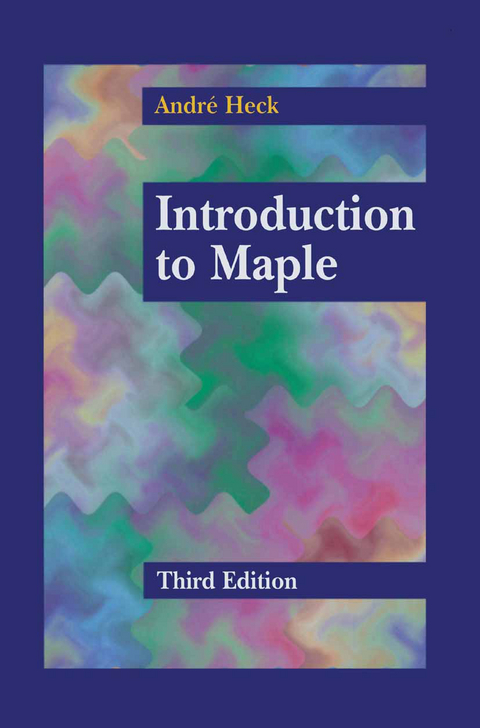Introduction to Maple
Seiten
2003
|
3rd ed. 2003
Springer-Verlag New York Inc.
978-0-387-00230-9 (ISBN)
Springer-Verlag New York Inc.
978-0-387-00230-9 (ISBN)
The first two editions of this book have been very well received by the com munity, but so many revisions ofthe Maple system have occurred since then that simply reprinting the out-of-stock book would not do anymore. Last, but not least, a new chapter on Grabner basis theory and the Groebner package in Maple has been added to the book.
The first two editions of this book have been very well received by the com munity, but so many revisions ofthe Maple system have occurred since then that simply reprinting the out-of-stock book would not do anymore. A ma jor revision of the book was inevitable, too. The wording "major revision" must be taken seriously because I not only corrected typographical errors, rephrased text fragments, and updated many examples, but I also rewrote complete chapters and added new material. In particular, the chapter on differential equations now discusses Liesymmetry methods, partial differen tial equations, and numerical methods. Linear algebra is based throughout the book on the packages LinearAlgebra and VectorCalculus, which re place the deprecated package linalg. Maple users are strongly advised to do their work with the new packages. The chapter on simplification has been updated and expanded; it discusses the use of assumptions in more detail now. Last, but not least, a new chapter on Grabner basis theory and the Groebner package in Maple has been added to the book. It includes many applications of Grabner basis theory. Many of the Maple sessions have been rewritten so that they comply with the most recent version of Maple. As a result of all this work, hardly any section in the book has been left untouched. vi Preface to the Third Edition From the Preface of the Second Edition The first edition ofthis book has been very wellreceived by the community.
The first two editions of this book have been very well received by the com munity, but so many revisions ofthe Maple system have occurred since then that simply reprinting the out-of-stock book would not do anymore. A ma jor revision of the book was inevitable, too. The wording "major revision" must be taken seriously because I not only corrected typographical errors, rephrased text fragments, and updated many examples, but I also rewrote complete chapters and added new material. In particular, the chapter on differential equations now discusses Liesymmetry methods, partial differen tial equations, and numerical methods. Linear algebra is based throughout the book on the packages LinearAlgebra and VectorCalculus, which re place the deprecated package linalg. Maple users are strongly advised to do their work with the new packages. The chapter on simplification has been updated and expanded; it discusses the use of assumptions in more detail now. Last, but not least, a new chapter on Grabner basis theory and the Groebner package in Maple has been added to the book. It includes many applications of Grabner basis theory. Many of the Maple sessions have been rewritten so that they comply with the most recent version of Maple. As a result of all this work, hardly any section in the book has been left untouched. vi Preface to the Third Edition From the Preface of the Second Edition The first edition ofthis book has been very wellreceived by the community.
1 Introduction to Computer Algebra.- 2 The First Steps: Calculus on Numbers.- 3 Variables and Names.- 4 Getting Around with Maple.- 5 Polynomials and Rational Functions.- 6 Internal Data Representation and Substitution.- 7 Manipulation of Polynomials and Rational Expressions.- 8 Functions.- 9 Differentiation.- 10 Integration and Summation.- 11 Series, Approximation, and Limits.- 12 Composite Data Types.- 13 The Assume Facility.- 14 Simplification.- 15 Graphics.- 16 Solving Equations.- 17 Differential Equations.- 18 The LinearAlgebra Package.- 19 Linear Algebra: Applications.- 20 A Bird’s-Eye View of Grobner Bases.- References.
| Erscheint lt. Verlag | 8.4.2003 |
|---|---|
| Zusatzinfo | XVI, 828 p. |
| Verlagsort | New York, NY |
| Sprache | englisch |
| Maße | 155 x 235 mm |
| Themenwelt | Mathematik / Informatik ► Informatik ► Software Entwicklung |
| Mathematik / Informatik ► Informatik ► Theorie / Studium | |
| Mathematik / Informatik ► Mathematik ► Algebra | |
| Mathematik / Informatik ► Mathematik ► Analysis | |
| Mathematik / Informatik ► Mathematik ► Computerprogramme / Computeralgebra | |
| Mathematik / Informatik ► Mathematik ► Wahrscheinlichkeit / Kombinatorik | |
| Naturwissenschaften ► Physik / Astronomie | |
| ISBN-10 | 0-387-00230-8 / 0387002308 |
| ISBN-13 | 978-0-387-00230-9 / 9780387002309 |
| Zustand | Neuware |
| Haben Sie eine Frage zum Produkt? |
Mehr entdecken
aus dem Bereich
aus dem Bereich
Deterministische und randomisierte Algorithmen
Buch | Softcover (2024)
De Gruyter Oldenbourg (Verlag)
64,95 €
Programmieren erlernen und technische Fragestellungen lösen
Buch | Softcover (2023)
Springer Vieweg (Verlag)
44,99 €




